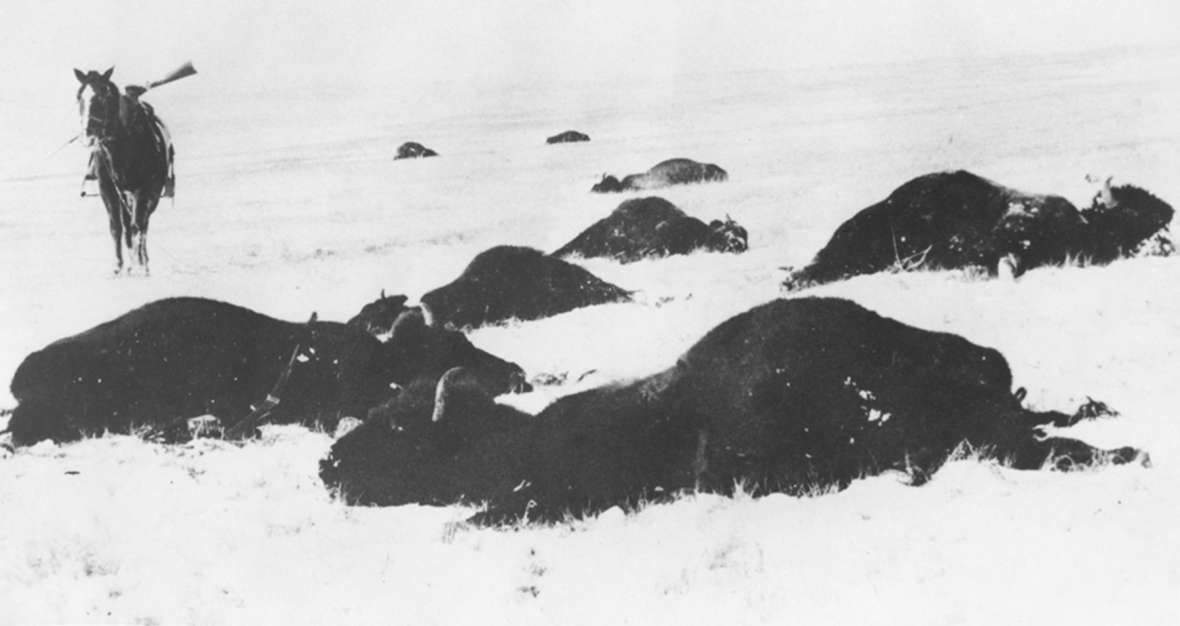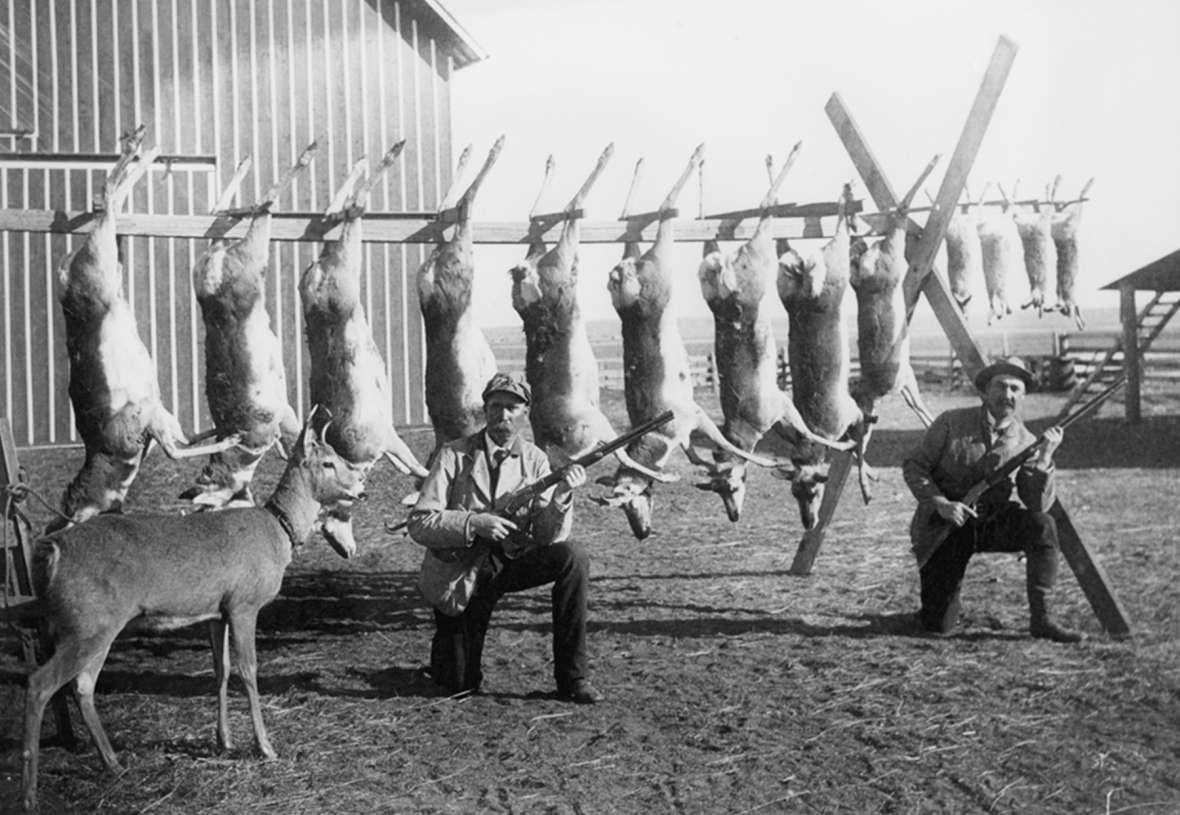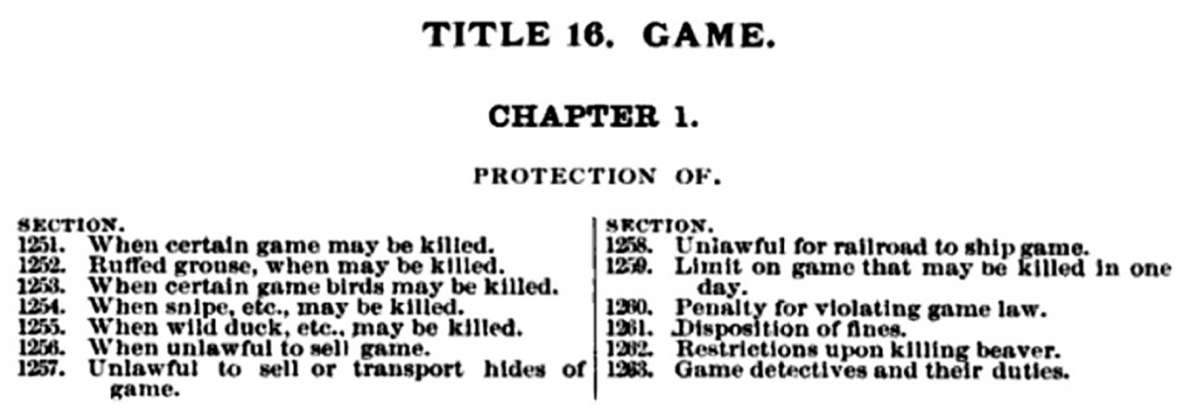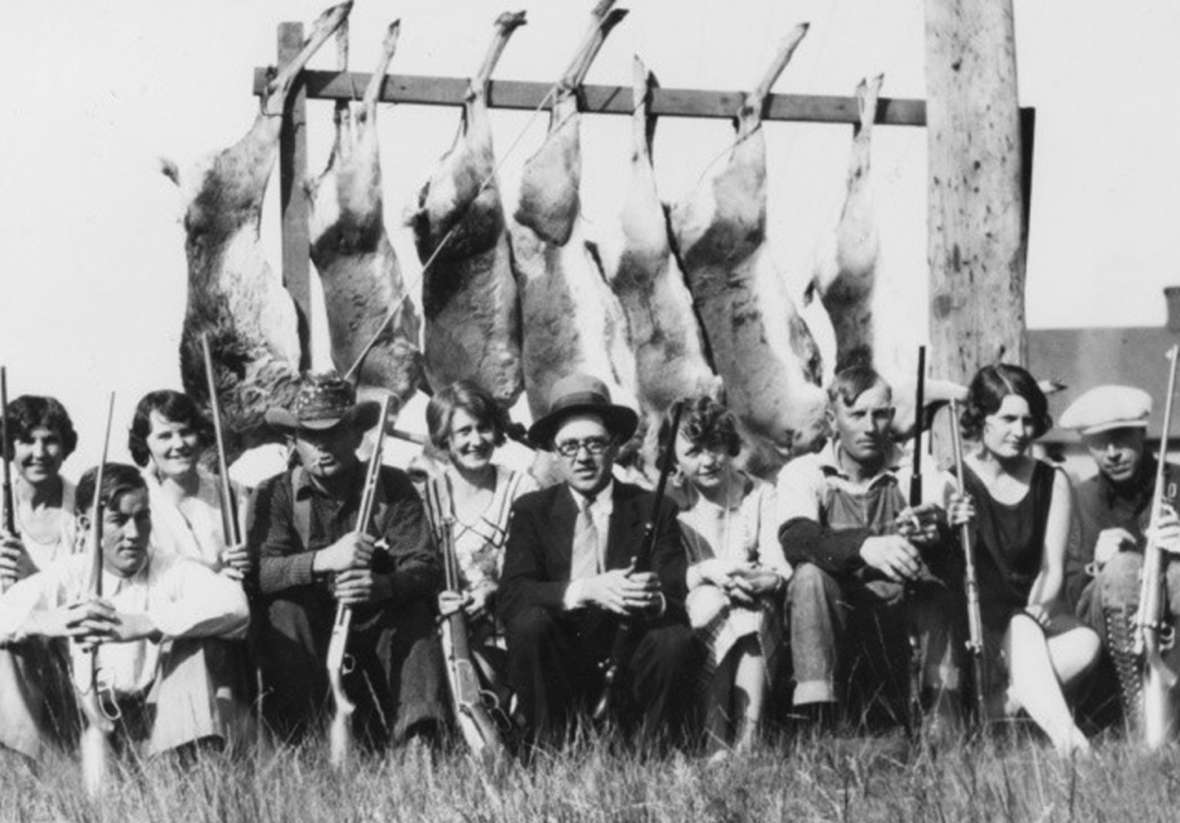- Home
- Encyclopedia
- From Slaughter To Law: Wyoming Protects Big Gam...
From Slaughter to Law: Wyoming Protects Big Game—Slowly
Most who know about the history of the American frontier are familiar with the demise of the buffalo. By the mid-1880s, herds that had once numbered in the millions on the Great Plains were almost completely wiped out. Twenty years later, a similar fate was facing deer, elk and especially antelope in Wyoming.
But people only slowly came to understand their own role in these disasters, and their minds, when it came to protecting big game, were slow to change. Early efforts by the Wyoming Legislature to stem the slaughter were largely ineffective. What follows is an account of how the state came around to protecting its big game herds in ways that allowed them to thrive.

Initial rudimentary measures
When Wyoming, not yet a territory, was still subject to Dakota Territory laws, lawmakers took a minor step to protect at least some game animals. In 1866 the Dakota legislature passed a law limiting hunting on private land to the owner. This had little impact in future Wyoming Territory because so little land was privately owned when the territory was first established—on paper at least—in 1868.
Dakota legislature’s attempt at control was likely a response to large-scale commercial hunting. Newspaper accounts in early 1868 noted Mr. S. Petty was ready to ship 3,000 deer, elk and antelope “heads” to eastern markets from Platte Crossing on the Overland Trail where it crossed the North Platte River south of the brand-new town of Rawlins. He employed 13 hunters who on average killed 28 animals each per day. That year, the Union Pacific Railroad was under construction.

J. J. Hunt, operating out of Fort Steele, reported he had killed 900 elk and antelope in the winter of 1868-69.
The first Wyoming Territory Legislative Assembly did pass a law on Dec. 1, 1869 providing limited additional protection. It became illegal for any person to offer for sale any elk, deer, antelope or “mountain sheep” between February and August. The law imposed a fine of $50 for any violation.
No enforcement mechanism
But there was no specific enforcement mechanism. And the law did little to stop wanton killing, mainly for hides and meat by commercial hunters. Laramie Sentinel editor James Hayford complained in early January 1870 that “loads upon loads of deer, elk and antelope” were being brought into town and much of the meat was wasted in a saturated market.
The Sentinel noted in November 1874 that Englishmen were in town and fitting out a hunting expedition around Laramie “to put in a month or two slaughtering game.” Similarly, Wyoming residents also engaged in pleasure hunting, killing large numbers of buffalo and antelope in a single outing. The Cheyenne paper reported on a hunting party in October 1875 that “killed a carload of game,” and that two men in the party killed 40-50 antelope.
In response to these types of events, the 1875 legislature amended the territory’s game laws. It closed hunting for deer, elk, “mountain sheep” and antelope from Jan. 15 to Aug. 15. The law also prohibited the wasting of any part of the animals taken during the open season and required that game be killed for “food purposes only.” However, as in 1869, no formal enforcement mechanism was provided.
That lack of enforcement was evident the next year when the Sentinel reported that a party of hunters were south of town slaughtering antelope for their hides. Prominent Laramie men also killed large numbers of game animals. The Cheyenne Sun noted on Sept. 12, 1877, that prominent local merchant Otto Gramm returned to Laramie after having “committed immense slaughter among elk and deer.” In 1878, Gramm was at it again along with banker Edward Ivinson, Louis Miller and William Root who returned to town from a hunt on which they killed “loads of game.”
Citizens take a stand
The effect on game herds, especially by the hide and meat hunters, eventually prompted citizens to take a stand against the depredation. The Nov. 18, 1881, Laramie Sentinel voiced their sentiment clearly.
Noting that there was a growing conviction that something needed to be done, the paper called on the legislature to take up the issue. Likely written by editor Hayford, the article notes, “If our laws for the protection of game are not sufficient for the purpose, right now is the time to call the attention of our legislators to its defects and have them remedied.” It also demanded the laws be enforced and violators punished.
Early the next year the Cheyenne Leader printed a similar column. It aimed specifically at men who had come up from Texas and were killing game only for their hides. These “hide grubbers” as the paper called them, could be stopped, the paper claimed, by prohibiting the sale or purchase of any untanned hides of deer and elk.
The Carbon County Journal followed suit, placing most of the blame on the “skin hunters” but also drew attention to the number of Englishmen who were killing large numbers of game, apparently for sport. Additionally, it called for game wardens to be hired to enforce the game laws. All three papers noted that Wyoming sportsmen were not to blame as they tended to kill only bucks and bulls, allowing the herd to replenish naturally.
Those efforts bore only limited fruit in the legislature’s next session. On March 9, 1882, the legislature passed an act that made a major revision to the hunting season, limiting it to Aug. 1 to Nov. 15. Additionally, the purchase of untanned hides was prohibited. Yet no limits were set on the number of animals that could be killed for personal consumption and no steps were taken toward enforcement.
The following year, Wyoming hunters made an abortive effort to band together to stop the slaughter. On March 1, 1883, the Laramie Boomerang reported that a group of men had formed the Laramie Game Protective Association of Wyoming Territory.
A similar association was formed in Cheyenne. This group published a letter from the governor of Montana to its president, area rancher Harry Oelrichs, calling for the protection of game in Yellowstone. Neither association, unfortunately, appears to have taken concrete steps beyond initial organization.

Uncontrolled killing continues
The killing continued unabated. In November of that same year, the Laramie Boomerang noted three market hunters killed “three ton” of elk in the northern Laramie Range and two others killed an additional “5,000 pounds” in the Medicine Bow Mountains. And that was elk only—the total did not include the deer and antelope they killed. Meanwhile, newspapers in both Laramie and Cheyenne continued to carry grocery store ads offering game for sale.
The situation continued to worsen. In October 1885, the Laramie Boomerang issued another call for better game-protection laws. Noting that a “legitimate hunt” is a good thing, and after criticizing hide hunters the article concluded, “It will be but a short time until the bear, the deer and the antelope will disappear, as has the buffalo, unless some steps are taken to prevent a wholesale slaughter, which is now the rule.”
First limits on game harvest; game detectives authorized
When the legislature convened in January 1886, its members took three important steps. First, no non-resident of the territory could hunt any big game at any time. Second, hunters were finally required to limit the number of animals they killed. Although still high at two per day, at least it was a start. Finally, a formal mechanism for enforcement was instituted. County stock detectives, authorized beginning in 1873, were also designated “game detectives” and empowered to enforce game laws.
But having a law on the books does not necessarily convert to action. A search of contemporaneous newspapers lists a George Lambert as Albany County stock detective at the time, though it is unclear how or even if he exercised his new authority. No reports of violations or arrests are to be found.
In fact, newspaper accounts from far western Albany County in January 1887 noted that large numbers of game animals were still being killed and sent to markets in Laramie. Similarly, the new legal open season for hunting, Sept. 1 to Jan. 1, was ignored when it was reported that two Laramie men killed six antelope in July with no repercussions.
Blatant violations appear to have been common. In June 1888, the Saratoga Lyre noted “Elk, deer and antelope can be killed within twenty miles of Saratoga in any quantities desired.” Antelope were especially vulnerable. The Laramie Boomerang reported in October 1888 that a group of hunters killed 100 antelope. Worse, the paper also reported the men only kept the “saddle meat”—the part of the animal corresponding to where a saddle covers a horse—and left the rest to rot.
The 1890 legislature enacted further limits on the number of large game animals hunters could kill. A limit of three per week replaced the earlier two-per-day number. Buffalo hunting was suspended for 10 years, even though there were no buffalo to hunt. Additionally, the legislature removed the authority of stock detectives to enforce game laws and instead empowered any county constable to do so. This theoretically increased the likelihood of punishing hunters for game violations.
At the time there were one stock detective in Albany County and 20 elected constables. As earlier, however, there is little or no evidence of enforcement at the time.

State game warden created; licenses required for non-resident hunters
Finally, in 1895, some important changes occurred. The state fish commissioner was also designated to be the state game warden and given the authority to arrest without warrant anyone violating state game laws. The legislature also allowed for the appointment of deputy game wardens.
The prohibition on hunting buffalo was extended until 1905. Non-residents were again allowed to hunt in the state, but first had to buy a hunting license from the justice of the peace in the county where they would hunt. The hunting season was shortened to September through November and the law allowed the killing of male animals only.
The first reported arrest for a violation occurred in October 1897 when Deputy Game Warden Joseph Nelson arrested a Chicago man for killing an elk in Uinta County without a license. In 1899 the first state game warden, Albert Nelson, was appointed separately from the fish commissioner.
According to the Wyoming Game Wardens Association, his salary was set at $1,200 per year from which he had to pay $3 per day to deputy state game wardens. Despite the new rules and their enforcement, the situation continued to deteriorate into the early 1900s.

State finally takes firm control
The state legislature finally got serious about protecting game. In 1903 all persons hunting in the state were required to purchase a hunting license. The legislature passed additional restrictive laws in 1909. The hunting of antelope was prohibited for six years and elk and moose for three. The latter could only be hunted in the northern part of the state. When the seasons opened, moose hunting was further restricted to Sept. 25 to Nov. 30.
The situation for antelope was especially dire. In 1906, officials estimated pronghorn numbers at only 2,000—their lowest level ever. By 1908, the number was up 4,000, with 2,000 of those in Yellowstone National Park.
The restrictions achieved the intended results. Herds began to increase, slowly. Antelope were a marked success. By 1924, their population was estimated at 7,000 head, but it was becoming clearer that competition from sheep and cattle for forage on the ranges was limiting antelope recovery. In 1927, an antelope season was opened for the first time in decades. Two years later, when hunters harvested more than 6,500, leaving a herd of 26,625, the New York Times decried the hunt as a slaughter, comparing it to the slaughter of the buffalo. In the early 1930s the state again closed the season for three years, and opened it again mid-decade.
By 1957, state estimates put the herd at 100,005 and the numbers have continued to rise—to approximately 400,000 today.
Great strides have been made in Wyoming since those early days. Big game in Wyoming is now skillfully managed by the Wyoming Game and Fish Commission with the laws enforced by about 90 dedicated game wardens. Environmental impacts such as wasting disease and drought still impact game herds in Wyoming and herd sizes are managed accordingly. And this controlled hunting is economically important to Wyoming. Spending by both residents and non-residents contributes about $3 million to the state’s economy each year and supports more than 3,000 jobs.
Resources
Primary Sources
- Dakota Territory Law 1866, accessed June 24, 2020 at https://babel.hathitrust.org/cgi/pt?id=nyp.33433086640897&view=1up&seq=67.
- Wyoming State Laws, accessed June 24, 2020:
- Wyoming Territory Laws, accessed June 24, 2020:
- 1869: https://babel.hathitrust.org/cgi/pt?id=nyp.33433007185063&view=1up&seq=311.
- 1875: https://babel.hathitrust.org/cgi/pt?id=nyp.33433007185477&view=1up&seq=522.
- 1882: https://babel.hathitrust.org/cgi/pt?id=nyp.33433007184876&view=1up&seq=141.
- 1886: https://books.google.com/books?id=7YU0AQAAMAAJ&pg=PA392&lpg=PA392&dq=session+laws+of+wyoming+territory+1886&source=bl&ots=hgVBy6x0i5&sig=ACfU3U0aHGk83LXk-cefJGKgo8NYEtOHDQ&hl=en&sa=X&ved=2ahUKEwjKp5aT_NboAhUjO30KHZbfAZI4ChDoATAGegQICRBG#v=onepage&q&f=false
- 1888: https://babel.hathitrust.org/cgi/pt?id=nyp.33433007185089&view=1up&seq=164.
- Wyoming Newspapers, accessed March 26 - April 15, 2020 at http://newspapers.wyo.gov/:
- Carbon County Journal. Feb. 25, 1882, p. 2, col. 5.
- Cheyenne Daily News. Oct. 9, 1875, p. 2, col. 1.
- Cheyenne Democratic Leader. Jan. 31, 1884, p. 10, col. 3; April 12, 1885, p. 1, col. 2.
- Cheyenne Leader. Feb. 27, 1868, p. 1, col. 3; March 12, 1869, p. 4, col. 2; Oct. 22, 1880, p. 4, col. 2; Jan. 26, 1882, p. 5, col. 3; Feb. 9, 1882, p. 2, col. 2; June 14, 1883, p. 4. col. 3; Dec. 6, 1889, p. 3, col. 3.
- Laramie Boomerang. March 1, 1883, p. 3, col. 3; Sept. 6, 1883, p. 8, col. 3; March 20, 1884, p. 2, col. 4; Oct. 29, 1885, p. 4 col. 3; June 14, 1888, p. 5, col. 3; Oct. 7, 1897, p. 8, col. 1.
- Laramie Sentinel. Nov. 25, 1874, p. 2 col. 1; Oct. 9, 1876, p. 4, col 2; July 2, 1877, p. 3, col. 3; Oct. 9, 1880, p. 1, col. 5; Nov. 19, 1881, p. 2. col. 2; Dec. 8, 1883, p. 4, col. 3.
Secondary Sources
- Erwin, Marie. Wyoming Historical Blue Book Vol. II. Wyoming State Archives and Historical Department, “Game and Fish Department.” Reprint 1974, 184, accessed April 5, 2020 at https://wyoarchives.wyo.gov/.
- Hornaday, William T. Our Vanishing Wildlife. New York: Charles Scribner, 1913, 159, accessed June 24, 2020 at http://www.gutenberg.org/ebooks/13249.
- Turbak, Gary. Pronghorn: Portrait of the American Antelope. Flagstaff, Ariz.: Northland Publishing, 1995, 20.
- Van Pelt, Lori. “Photographer on the Pitchfork: Charles Belden’s Version of the West.” WyoHistory.org, accessed June 24, 2020 at /encyclopedia/photographer-pitchfork-charles-beldens-version-west.
- Wyoming Game Wardens Association. “History of Wyoming Wildlife Law Enforcement,” accessed March 30, 2020 at https://www.wyominggamewardens.com.
Illustrations
- The photos of the dead buffalo and the photos of the hunters with their antelope harvests are all from the Wyoming State Archives; the photo of the two hunters with 13 antelope is by J.E. Stimson. Used with permission and thanks.
- The color photo of the pronghorn buck is by Yathin S Krishnappa, on Wikipedia. Used with thanks.
- The image of the list of game statutes is from the Wyoming Territory Laws for 1886. Used with thanks.
